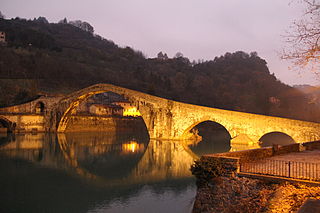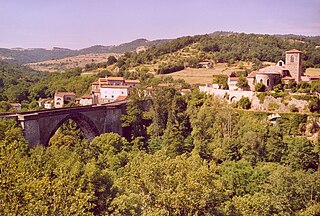
The Nyons Bridge is a medieval bridge over the river Eygues in Nyons in southern France.
The bridge was completed in 1407. It features a single span of 40.53 m, quite large for the standards of the day.

The Nyons Bridge is a medieval bridge over the river Eygues in Nyons in southern France.
The bridge was completed in 1407. It features a single span of 40.53 m, quite large for the standards of the day.
Other very large medieval bridges
Coordinates: 44°21′36″N5°8′39″E / 44.36000°N 5.14417°E

A cable-stayed bridge has one or more towers, from which cables support the bridge deck. A distinctive feature are the cables or stays, which run directly from the tower to the deck, normally forming a fan-like pattern or a series of parallel lines. This is in contrast to the modern suspension bridge, where the cables supporting the deck are suspended vertically from the main cable, anchored at both ends of the bridge and running between the towers. The cable-stayed bridge is optimal for spans longer than cantilever bridges and shorter than suspension bridges. This is the range within which cantilever bridges would rapidly grow heavier, and suspension bridge cabling would be more costly.

An arch bridge is a bridge with abutments at each end shaped as a curved arch. Arch bridges work by transferring the weight of the bridge and its loads partially into a horizontal thrust restrained by the abutments at either side. A viaduct may be made from a series of arches, although other more economical structures are typically used today.

The Pont Saint-Bénézet, also known as the Pont d'Avignon, was a medieval bridge across the Rhône in the town of Avignon, in southern France. Only four arches survive.

The Alconétar Bridge, also known as Puente de Mantible, was a Roman segmental arch bridge in the Extremadura region, Spain. The ancient structure, which featured flattened arches with a span-to-rise ratio of 4–5:1, is one of the earliest of its kind. Due to its design, it is assumed that the bridge was erected in the early 2nd century AD by the emperors Trajan or Hadrian, possibly under the guidance of Apollodorus of Damascus, the most famous architect of the time.

The Trezzo sull'Adda Bridge or Trezzo Bridge was a medieval bridge at Trezzo sull'Adda in Lombardy, Italy, spanning the Adda river. Completed in 1377, the single-arch bridge held the record for the largest span for over four hundred years, until the beginnings of the Industrial Age, while it was not until the early 20th century that masonry bridges with larger openings were constructed.

Ponte della Maddalena is a bridge crossing the Serchio river near the town of Borgo a Mozzano in the Italian province of Lucca. It's one of numerous medieval bridges known as Ponte del Diavolo, the "Bridge of the Devil", it was a vital river crossing on the Via Francigena, an early medieval road to Rome for those coming from France that was an important medieval pilgrimage route.

Viaduc d'Austerlitz is a single-deck, steel arch, rail bridge that crosses the Seine in Paris. Its usage is solely dedicated to Line 5 of the Paris Métro. It links Gare d'Austerlitz on the Rive Gauche to Quai de la Rapée on the other side of the river.

Faidherbe Bridge is a road bridge over the Senegal River which links the island of the city of Saint-Louis in Senegal to the African mainland. The metal bridge is 507.35 m (1,664.5 ft) long and 10.5 m (34 ft) wide, weighing 1,500 t. It has eight spans, of which the longest five are 78.26 m (256.8 ft).

The Pont du Diable or Pont Vieux is a medieval stone arch bridge at Céret, France, built between 1321 and 1341. It spans the Tech River with a single arch of 45.45 metres (149.1 ft). At its apex, the arch is 22.3 metres (73 ft) high.

The Pont Grand is a stone bridge connecting Tournon-sur-Rhône to Saint-Jean-de-Muzols, in Ardèche, France, built between 1379 and 1583. The bridge features a single, semi-circular arch over the river Doux with a span of 49.20 m. The height of the piers is 17.73 m.

The Puente de San Martín is a medieval bridge across the river Tagus in Toledo, Spain.

The Pont del Diable, also known as Sant Bartomeu Bridge, is a medieval bridge crossing the river Llobregat and straddling the municipalities of Martorell and Castellbisbal in Catalonia, Spain. The bridge is restricted to pedestrians.

Pont de Vieille-Brioude is located in France, crossing the river Allier. It is a masonry arch bridge with a span of 45 metres (148 ft) that was built in 1832.

The Pont sur la Laye or Pont roman de Mane is an old stone arch bridge across the stream Laye in the French Provence close to the town Mane.

The Pont de Bornègre is an ancient bridge of the Roman aqueduct to Nîmes, which also includes the famous Pont du Gard, between the communes of Saint-Maximin, and Argilliers. It is located at the upper reaches of the approximately 50 km long aqueduct, 6,745 m downstream of the Eure source and 9,061 m upstream of the Pont du Gard. The structure bridges an intermittent torrent, the Bordnègre, with a catchment area of 0.6–0.8 km2 and, according to modern estimates, a maximum flood flow of 5 m3/s water.